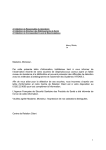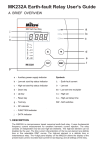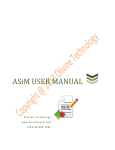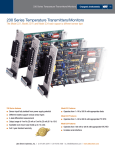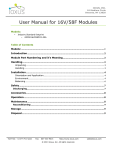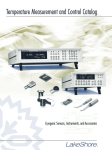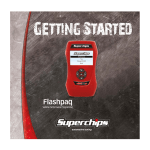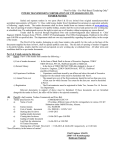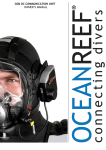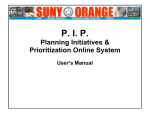Download SUNY Oneonta Sculpture Studios Handbook
Transcript
SUNY Oneonta Sculpture Studios Handbook Your guide to the safe and efficient usage of the sculpture studios at SUNY Oneonta h t t p : / / e m p l o y e e s . o n e o n t a . e d u / s a k o u l t / s c u l p t u r e / f a c i l i t i e s . h t m l State University of New York, College at Oneonta – Art Department Sculpture Studios Handbook Table of Contents ABOUT THIS HANDBOOK ..................................................................................................................................... 3 GENERAL STUDIO POLICIES AND PROCEDURES .......................................................................................... 4 GUIDELINES FOR STUDENT USAGE OF THE STUDIOS ............................................................................................................. 5 SAFETY ........................................................................................................................................................................................... 6 EMERGENCY PROTOCOL .............................................................................................................................................................. 7 COMFORT ....................................................................................................................................................................................... 7 CLEANLINESS ................................................................................................................................................................................ 7 STORAGE AND LOCKERS .............................................................................................................................................................. 8 SCULPTURE STUDIOS INFORMATION .............................................................................................................. 9 HOURS ......................................................................................................................................................................................... 10 ACCESS ........................................................................................................................................................................................ 10 PERSONNEL ................................................................................................................................................................................ 10 FLOOR PLAN AND EQUIPMENT LAYOUT ............................................................................................................................... 11 TOOL ROOM FA 234A ............................................................................................................................................................. 12 WOODSHOP FA 234 ................................................................................................................................................................. 12 ASSEMBLY ROOM FA 234F .................................................................................................................................................... 19 “THE DIGITAL FOUNDRY” COMPUTER LAB FA 234D ....................................................................................................... 19 METAL & STONE STUDIO FA 233 ........................................................................................................................................ 20 CNC ROOM FA 233A ............................................................................................................................................................... 28 GRINDING/SANDING ROOM FA 233B .................................................................................................................................. 28 METAL FOUNDRY FA A-‐233 .................................................................................................................................................. 29 PLASTER ROOM FA 234C ....................................................................................................................................................... 32 WAX ROOM FA 234E .............................................................................................................................................................. 32 Visit http://employees.oneonta.edu/sakoult/sculpture/facilities.html for updates and more resources. 2 State University of New York, College at Oneonta – Art Department Sculpture Studios Handbook About This Handbook This handbook provides information about the Sculpture Studios of the Art Department at SUNY Oneonta, which consist of rooms FA 233, FA 234, and all the subdivisions within. It is required reading for all who have been approved to use the studios. An electronic version of this handbook with updates, and additional resources can be found at http://employees.oneonta.edu/sakoult/sculpture/facilities.html This handbook is not an exhaustive resource, but it is designed to provide basic information and policies that ensure the safe use of the facilities and tools. This handbook is written and maintained by Professor and 3D Studio Coordinator, Thomás Sakoulas. Please send all comments and suggestions regarding the contents of this handbook to [email protected] This copy was updated: Fall 2013 Visit http://employees.oneonta.edu/sakoult/sculpture/facilities.html for updates and more resources. 3 State University of New York, College at Oneonta – Art Department Sculpture Studios Handbook General Studio Policies and Procedures Visit http://employees.oneonta.edu/sakoult/sculpture/facilities.html for updates and more resources. 4 State University of New York, College at Oneonta – Art Department Sculpture Studios Handbook Guidelines for Student Usage of the Studios • • • • • • • • • • • • • • Only authorized persons may use the sculpture studios. Read the studio Handbook and become familiar with the facilities. Memorize and observe all safety rules. Use the Sculpture studios only for class projects. Eye protection is required when entering the sculpture studios. Use only tools and materials that have been approved by your instructor. Return all tools to their proper storage place after use. Store your work safely out of the way when you are done. Clean up your area. Students, faculty and staff who use the studio must clean up their mess before leaving. Allow extra time at the end of each class for cleanup. No guests allowed in the sculpture studios. No horseplay! Students who are authorized to use the studios may not bring unauthorized persons into the studio at any time. Only students enrolled in a class that requires the use of the Sculpture studios are allowed in the facilities. Others may use the studios only with special permission of the 3D Studio Coordinator. Authorized students must attend an orientation regarding access, safety, security, studio maintenance, supplies usage, policies and practices. Each professor will provide the orientation in the first weeks of each semester. After-‐hours use of the studio will be granted to students who are enrolled in a course that requires the use of the 3D Studios. Access to the sculpture studios may be revoked at any time. Reasons for revoking access to the studios include – but not limited to – violations that lead to safety, cleanliness, or security issues. Visit http://employees.oneonta.edu/sakoult/sculpture/facilities.html for updates and more resources. 5 State University of New York, College at Oneonta – Art Department Sculpture Studios Handbook Safety Don’t compromise your personal safety, or the safety of those around you. A momentary lapse of attention or reason can affect you or your classmates for life. Pay attention, be alert, and follow instructions! Memorize and follow these simple rules: • Report all health/respiratory issues to your professor at the beginning of the semester. • Wear eye protection at all times in the studios. Students must provide their own safety glasses or goggles equipped with wrap-‐around eye shields. • Pull back long hair, and tuck away loose clothing, remove all jewelry that might constitute an obstruction (bulky rings, necklaces, long earrings etc.), tuck in loose clothing, and make sure that your sleeves are buttoned or rolled above the elbows. • Always wear appropriate clothing and gear in the studios. Do not wear open-‐toe shoes, or loose or dangling clothes. Neckties are forbidden. • Do not use a particular tool without help if you are not sure what you are doing. • Do not use tools if you are ill or under the influence of any substance or medication that might impair your abilities, or when you feel particularly tired. • Do not use tools if you are frustrated with your work (take a break and continue your work when you feel calmer), or when you are in a hurry (plan ahead and do not leave the bulk of the work for last minute). • Always maintain a comfortable posture and keep your workspace (including the floor) free of obstructions and excessive debris. • Ask for help if you need it or when you are uncertain whether or not you need it. • Do not distract someone who is using a power tool. • Use clamps to secure your work. Be certain that your work is anchored before proceeding with the use of portable power tools. • Be certain that all lumber is free of nails, dirt, paint, or loose knots before you machine it. Do not cut through wood knots in the wood. Pay special attention if the wood is warped. • Do not use any tool that does not appear to be in good working order. • Use tools for the purpose for which they were designed. If you are not sure, ask. • Unplug power tools or remove batteries before changing blades, disks, bits, etc. • Do not remove machine guards and do not tamper with the safety gear, or the lock mechanism of the tools and machinery. • Report all non-‐injury accidents to your instructor. • Report all malfunctioning tools to your instructor. If that’s not possible, place a written note on the machine to inform subsequent users of a potential problem. • Do not attempt to repair any machines or tools yourself. • In case of immediate danger, push one of the power cut-‐off switches (red, round buttons) that are situated throughout the studio walls. • No spray paint, or solvents of any kind are allowed in the studio at any time. All spray painting must be done outside. • Ensure that your tool can’t fly out of control and hit you, that you don’t fall into a working machine, and that your work does not get knocked into you. 6 Visit http://employees.oneonta.edu/sakoult/sculpture/facilities.html for updates and more resources. State University of New York, College at Oneonta – Art Department Sculpture Studios Handbook Emergency Protocol 1. 2. 3. 4. Move away from any danger. Call 911. From a cell phone, call University Police: (607) 436-‐3550 If possible, stay in a safe area nearby to provide information to emergency personnel. Notify your professor as soon as possible. Comfort Appropriate clothing required for each process. Follow you professor’s instructions. In general, dress for a mess. Even if your own work does not seem to be messy, other’s mess might affect you. • Open music in the studio is allowed as long as no one objects to it. Be respectful of others when playing your music in the open. • Headphones and personal music players are allowed when power tools are not used make sure you can hear your surroundings. • Pace your work. Most three-‐dimensional work is physical and can’t be done in one sitting or in one night. Cleanliness There are over one hundred students using the sculpture studios each semester and some processes are messy. Please help keep the studios as clean as possible for everyone. • Clean up your area from debris immediately after you finish working. • Put all tools away in their proper storage place after you have cleaned them from all debris. • Remove from the studio all materials not used for your immediate project., and remove all your personal belongings immediately after the final critique. • Participate in the communal clean up at the end of the semester. Your professor will inform you of the date and time of the studio clean up. Visit http://employees.oneonta.edu/sakoult/sculpture/facilities.html for updates and more resources. 7 State University of New York, College at Oneonta – Art Department Sculpture Studios Handbook Storage and Lockers Storage in the studios is extremely limited. While some temporary storage is possible, keep in mind that there is no 24-‐hour guard in the studio and therefore no one can guarantee that items stored in the open are secure. Take home all valuable/irreplaceable personal artifacts. • All stored materials must be labeled with the student’s full name, class, semester, and year. Unlabeled projects and materials are subject to removal at any time. • Students may store temporarily all the required materials for the completion of their class projects. • Small items should be placed in the student’s locker, and open shelves, while large materials may be stored temporarily around the studios for a limited time. Talk to your professor to find a suitable and safe are to store large personal items. • All materials and artwork (personal items) must be removed at the end of the semester. Professors will provide specific deadlines for removing personal items from the studios, but if they don’t, the final deadline to remove personal items is the end of the class’ final critique. • The lockers in the sculpture studios are available for student use on a first-‐come, first-‐serve basis. Students must label their locker with their full name, course number, and semester. Locked lockers that are not labeled may be cut open at any time. All lockers must be emptied and cleaned immediately after the conclusion of the class’ final critique. Items left behind will be recycled or discarded. • Failure to remove personal items before the deadline can affect student grades and/or future access to the studios. Visit http://employees.oneonta.edu/sakoult/sculpture/facilities.html for updates and more resources. 8 State University of New York, College at Oneonta – Art Department Sculpture Studios Handbook Sculpture Studios Information Visit http://employees.oneonta.edu/sakoult/sculpture/facilities.html for updates and more resources. 9 State University of New York, College at Oneonta – Art Department Sculpture Studios Handbook Hours During the semester, excluding breaks, the studio hours are: Monday through Friday from 6am to 11pm, Saturday and Sunday 9am to 11pm Class schedule for each semester is posted outside the door of the studios. The studios are available to authorized students whenever there is no class meeting. When a class is in session, it is possible for authorized students to use the studios by asking permission from the professor in advance. The studios are closed during all official college recesses. Check the official college calendar to find out when the college is officially closed: http://www.oneonta.edu/admin/registrar/ Access The doors to the sculpture studios are to remain locked at all times. Students who are enrolled in relevant classes can unlock the doors with their student ID. Do not prop the doors open. Please carry your student ID with you at all times and don’t provide access to anyone who is not authorized to use the studios. Personnel 3D Studio Coordinator: Associate Professor Thomás Sakoulas ([email protected]) Tel: 607 436-‐2687. Professors: Several professors use the sculpture studios, including Professor Yolanda Sharpe and Adjunct Instructor Cooper Paulson. Studio Assistant: David Kenny ([email protected]) and Aaron Roman ([email protected] ) The studio assistant supervises the sculpture studios and is available to assist professors and students with their projects. The studio assistant has wide knowledge of the facilities and is familiar with the safe use of all tools. Teaching Assistants: Certain classes have a “teaching assistant”. Teaching Assistants are advanced students, chosen by professors to aid with all classroom tasks. They are usually present during the class meetings, but it is possible for professors to assign them off-‐class duty. 3D Studio monitors are present whenever possible. They are student workers who assist in good maintenance and safe usage of the studios. They can provide access to tools, basic information, and they monitor the use of the studios with regards to safety and security. Visit http://employees.oneonta.edu/sakoult/sculpture/facilities.html for updates and more resources. 10 State University of New York, College at Oneonta – Art Department Sculpture Studios Handbook Floor Plan and Equipment Layout Visit http://employees.oneonta.edu/sakoult/sculpture/facilities.html for updates and more resources. 11 State University of New York, College at Oneonta – Art Department Sculpture Studios Handbook Tool Room FA 234A All hand tools, and portable power tools are stored here. Students may use any tool that has been approved by their professor. 3D Studio Monitors (Work Study students) are stationed in the room and provide assistance with tool location, cleanliness, safety, and security. Students involved in class projects may checkout tools to use in the studio areas. At the end of the day the tools must be returned to their proper storage place in a reasonably clean state. The tools cannot be borrowed to use outside the sculpture studios. If a tool has been damaged during use, students must inform one of the studio personnel immediately. Woodshop FA 234 This studio is used for all woodwork, stone carving, and 3D Design classes. Equipment in this room include: Air supply There are multiple outlets for air tools around the walls and over the tables. Power supply There are numerous 110V outlets around the room and over the tables in retractable extension cords. Central dust collection This system must be powered whenever dust-‐producing processes occur in the room. Pull the “snorkel” close to your work and open the gate. Make sure all the other snorkels Visit http://employees.oneonta.edu/sakoult/sculpture/facilities.html for updates and more resources. 12 State University of New York, College at Oneonta – Art Department Sculpture Studios Handbook in the room are closed so you get maximum extraction power to your station. Because the dust collectors are very loud, everyone in the studio must use ear protection. Downdraft table This downdraft table must be used for cutting, grinding, and sanding of wood or stone. Because the downdraft table is very loud, everyone in the studio must use ear protection. Visit http://employees.oneonta.edu/sakoult/sculpture/facilities.html for updates and more resources. 13 State University of New York, College at Oneonta – Art Department Sculpture Studios Handbook Radial arm saw This saw is fitted with a dado blade. Not to be used for simple cutting of wood. It is connected to its own dedicated portable dust collector which must be powered separately whenever the radial arm saw is in use. Absolutely no ripping is allowed on this saw. Instruction Manual OSHA safety information Table saw The table saw is outfitted with a blade guard, kick-‐back arrestor, an aluminum fence, and an out-‐feed roller table which must be unfolded when long stock is cut. Tampering with the safety features of the table saw is a serious violation and can result in serious injury. No cutting is allowed without the blade guard lowered over the blade. Ripping and cross-‐cutting is allowed, however large sheets of plywood can be cut on the panel saw more safely. User Manual Read this Safety Review from OSHA before operating this machine. Visit http://employees.oneonta.edu/sakoult/sculpture/facilities.html for updates and more resources. 14 State University of New York, College at Oneonta – Art Department Sculpture Studios Handbook Panel Saw The panel saw is used to crosscut large pieces of plywood. User Manual Read this Safety Review from OSHA before operating this machine. Drill presses User Manual 20” Band saw Visit http://employees.oneonta.edu/sakoult/sculpture/facilities.html for updates and more resources. 15 State University of New York, College at Oneonta – Art Department Sculpture Studios Handbook User Manual Read this Safety Review from OSHA before operating this machine. Two Compound miter saws User Manual Read this Safety Review from OSHA before operating this machine. Visit http://employees.oneonta.edu/sakoult/sculpture/facilities.html for updates and more resources. 16 State University of New York, College at Oneonta – Art Department Sculpture Studios Handbook Scroll saw User Manual Read this Safety Review from OSHA before operating this machine. Disk/Belt sander The disk/belt sander is attached to a portable dust collector that must be powered separately when the machine is in use. User Manual Visit http://employees.oneonta.edu/sakoult/sculpture/facilities.html for updates and more resources. 17 State University of New York, College at Oneonta – Art Department Sculpture Studios Handbook Planer User Manual Jointer User Manual Visit http://employees.oneonta.edu/sakoult/sculpture/facilities.html for updates and more resources. 18 State University of New York, College at Oneonta – Art Department Sculpture Studios Handbook Assembly Room FA 234F This is a “clean room” for lectures and slide demonstrations. No dust-‐producing processes are allowed in this room. The large table in the middle of the room is suited for “clean” processes such as drawing, model making, etc. Equipment in this room includes: Podium The podium contains a computer, monitor, and DVD player. It is reserved for professors, but students may use the computer with permission. Use your SUNY username and password to login. Brown Paper Dispenser Brown paper is used extensively around the studio to lineup the workstations and to protect the machinery. Storage Shelves Temporary storage for small student projects “The Digital Foundry” Computer Lab FA 234D This studio may be used by students only with special permission. It is used for creating digital sculpture and rapid prototyping. Equipment in this room includes: Computer workstation This computer is exclusively used for creating digital sculpture in the included software (Solidworks). Students may use the computer with special permission and only for working on Solidworks. Visit http://employees.oneonta.edu/sakoult/sculpture/facilities.html for updates and more resources. 19 State University of New York, College at Oneonta – Art Department Sculpture Studios Handbook 3D Printer This rapid prototyping machine can process three-‐dimensional digital objects in a special plastic material. Students are not allowed to use the machine on their own; rather, prototypes are processed by the studio personnel. Since the material is very expensive, students are allocated a specific amount through their class fee. Consequently, only students who are enrolled in a Sculpture class may submit digital work for output on the 3D printer. Metal & Stone Studio FA 233 This studio is reserved for work in steel and stone. No woodworking allowed. There is a dedicated welding area separated from the rest of the studio with welding curtains, and a well equipped cold metal shop. Equipment in this studio includes: Visit http://employees.oneonta.edu/sakoult/sculpture/facilities.html for updates and more resources. 20 State University of New York, College at Oneonta – Art Department Sculpture Studios Handbook Two Plasma cutters (with manual torch) Plasma cutter with machine torch This plasma cutter is connected to the CNC plasma-‐cutting machine. CNC plasma cutter This machine is connected to a dedicated plasma cutter and a Dell computer. It is capable of cutting computer generated 2-‐D shapes out of steel. The table accomodates a 4 x 10 ft. sheet and can cut steel or aluminum. Visit http://employees.oneonta.edu/sakoult/sculpture/facilities.html for updates and more resources. 21 State University of New York, College at Oneonta – Art Department Sculpture Studios Handbook MIG welder The MIG welder can weld steel or aluminum. User Manual ARC welder User Manual Visit http://employees.oneonta.edu/sakoult/sculpture/facilities.html for updates and more resources. 22 State University of New York, College at Oneonta – Art Department Sculpture Studios Handbook Dust extraction over the worktable Spot Welder This welder is to be used for steel only. User Manual Visit http://employees.oneonta.edu/sakoult/sculpture/facilities.html for updates and more resources. 23 State University of New York, College at Oneonta – Art Department Sculpture Studios Handbook Drill press This drill press is reserved for metal drilling only. User Manual Slip roller The slip roller is used to create curves out of flat sheets of steel or aluminum. It is manually operated through a crank. Visit http://employees.oneonta.edu/sakoult/sculpture/facilities.html for updates and more resources. 24 State University of New York, College at Oneonta – Art Department Sculpture Studios Handbook Metal Sheer The sheer is used to cut sheets of metal. It is a foot-‐operated sheer. Bridge Saw This “wet” saw is used for cutting stone. No other material is allowed on this bridge saw. DO NOT CUT METAL OR WOOD. It is outfitted with a diamond blade and a water pump for circulating water over the blade. Visit http://employees.oneonta.edu/sakoult/sculpture/facilities.html for updates and more resources. 25 State University of New York, College at Oneonta – Art Department Sculpture Studios Handbook Abrasive cutoff saw The abrasive cutoff saw is used for chopping thin pieces of steel such as rebar, round stock, square stock, pipes, etc. Do not use this saw to cut aluminum. User Manual Read this Safety Review from OSHA before operating this machine. Horizontal band saw It is used for cutting thick pieces of steel or aluminum such as rebar, round stock, square stock, pipes, etc. Check with our professor before cutting aluminum with the horizontal band saw. User Manual Visit http://employees.oneonta.edu/sakoult/sculpture/facilities.html for updates and more resources. 26 State University of New York, College at Oneonta – Art Department Sculpture Studios Handbook Bench grinder Impact goggles AND a face shield are required whenever an angle grinder is used. Do not wear gloves when using the bench grinder. User Manual Buffer The buffer is used to polish small metal pieces of art. Impact goggles AND a face shield are required using the buffer. User Manual Visit http://employees.oneonta.edu/sakoult/sculpture/facilities.html for updates and more resources. 27 State University of New York, College at Oneonta – Art Department Sculpture Studios Handbook CNC Room FA 233A The CNC room is used by the operator of the CNC plasma-‐cutting machine. Grinding/Sanding Room FA 233B The grinding room is used whenever heavy metal grinding or stone sanding is required. Equipment in this room includes: Downdraft table This downdraft table is used for steel grinding. DO NOT GRIND ALUMINUM on this downdraft table, as it can be an explosion hazard. Impact goggles AND a face shield are required whenever a grinder is used. Portable wire brush This is a very temperamental tool and requires special attention from the operator. Impact goggles AND a face shield arerequired whenever a wire brush is used. Visit http://employees.oneonta.edu/sakoult/sculpture/facilities.html for updates and more resources. 28 State University of New York, College at Oneonta – Art Department Sculpture Studios Handbook Stainless Steel Sink This sink is used for “wet sanding” of stone. Metal Foundry FA A-‐233 The metal foundry is used for casting various metals. In our classes we use primarily the “lost wax” method. Only students with special permission may use the equipment in this studio. Equipment in this room include: Speedy Melt furnace used for melting bronze and aluminum. Visit http://employees.oneonta.edu/sakoult/sculpture/facilities.html for updates and more resources. 29 State University of New York, College at Oneonta – Art Department Sculpture Studios Handbook Burn-‐out Car Kiln This kiln is used exclusively for the burn-‐out step in the lost wax process. Sand blaster This self-‐contained unit is used to clean up metal after casting. Visit http://employees.oneonta.edu/sakoult/sculpture/facilities.html for updates and more resources. 30 State University of New York, College at Oneonta – Art Department Sculpture Studios Handbook Walk stacker This machine is used for transporting heavy materials around the studio. Only authorized personnel may use the walk stacker. Crane Only authorized personnel may use the crane. Hoist The hoist is used to support the crucible of molten metal, and to bring heavy materials into the studios since the I-‐beam extends outside the doors. Only authorized personnel may use the hoist. Visit http://employees.oneonta.edu/sakoult/sculpture/facilities.html for updates and more resources. 31 State University of New York, College at Oneonta – Art Department Sculpture Studios Handbook Plaster Room FA 234C This is the room where all plaster mixing, mold-‐making, casting, and investment for the metal foundry takes place. No wet plaster is allowed outside this studio. The studio is equipped with a large sink. Please never pour plaster down the sink as it will clog the plumbing. If you have excess plaster to discard, wait until it hardens and then dispose of it in the trash. Never allow plaster to come in contact with clay objects you intent to fire in a kiln. They will explode during fire if the slightest plaster is present. Because plaster is messy, students are required to clean up their area thoroughly before leaving the studio. Wax Room FA 234E The wax room is reserved for the creation of original wax artwork as well as wax casting, both for use in the lost wax process. Wax is flammable, so pay extra attention to your process and never leave your work (molten, or melting wax) unattended even for a few minutes. Similarly, clean up your area thoroughly and scrape wax from the counters, tools, and containers, before leaving for the day. Always wear protective clothing and goggles in case hot wax splashes on your person. Only use the studio’s special wax double boilers to melt wax. Never melt wax in a single container placed on a hot plate or fire. Visit http://employees.oneonta.edu/sakoult/sculpture/facilities.html for updates and more resources. 32
































